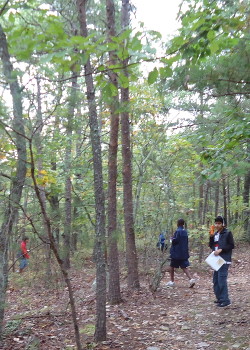43 — Avatar Club ARDF/nature walk event.
2015-10-25. By Patrick.

Fig. 1. Students searching for a transmitter during the Avatar Club ARDF event.
The Avatar Club went off really well. We were expecting heavy rain. The homing/demonstration transmitter was still untested in the field and had only limited functionality. We had not had chance to scout-out the area ahead of time. When I got to the park to set up the equipment, the gate was closed. When I finally got to the spot we had decided on, there was too much under-brush for clean runs through the woods. But it all still went off really well.
The rain stopped as I arrived and never returned. Maintenance arrived and opened the gate a bit ahead of time. I rushed up to our spot and found all this brush. Hum. OK, they'll go around our area using the bounding trails. I'll place the transmitters about 16 paces away from the trail, out of site from the trail, and in areas where the brush isn't too bad. Did that. Went back to "home-base" to set up our newest transmitter to be set up for demonstrations. When I got there, I could still hear both foxes. Super! I set up the demonstration transmitter. It was the first time it had ever been connected to an antenna. Turned it on with trepidation... Wow! That's loud. OK, no problem here. I rushed back down to the parking lot to await for the teachers and kids to arrive.
After they arrived, we separated into two groups. I was with Tony, one of the teachers. And Kelly did the nature/geology walk with the other teacher. Our group started out going over how to use a map and compass so that the kids could get a feel for it as we hiked up to home-base. When we got there, they were told how to find the foxes by hiking down the trail starting out eastward and always searching to the left. When they heard the fox was the loudest or at a right angle using the null, they were to switch to just using the null and go off trail for 20 paces at most. There was a small flag and a plastic box by each transmitter. The kids were to grab a colored wall anchor from the box to prove they had found the transmitter. Or, at least, that's what I had planned on...
But before I was done explaining all the details of transmitter hunting, it became obvious they just wanted to get out and try it. That was really cool. I rushed to get receivers into their hands. There were a few problems here but it helped in spacing out the groups. After the last student had a transmitter, I went out to be with the kids. At first, they couldn't find anything. But with a bit of guidance, almost all found both transmitters. In the end, all the group 1 kids seemed to be happy with how it had gone.
Group 2 was a bit tougher because we had very little time and more students. So we sent the kids out in groups of two just to find the fox 1. One kid had the map and compass; the other had the receiver. Since all the receivers were ready, the kids went out much faster. Eventually they all ended in the general area where fox-1 was. But they were not finding it. I think they were having trouble getting bearings as the signal grew louder. With so many kids in one area, the flag was eventually seen by one of the kids without a receiver. It was just luck. Oh-well. This group also seemed pretty happy at the end.
So considering the desperate rush to get all transmitter built in time for the event and the other problems that came up, I'm pretty happy with how it went. Lessons learned... The very small area with transmitters clearly audible worked really well for students that had never done it before. The students didn't really understand how to handle the equipment in the short amount of time. There needed to be more practice time. One aspect that was useful for kids that had never seen the equipment, was the transmitters all being close to the trail and on only one side. It made it that no instruction on how to use the sense antenna was needed.
In the future, I think I would like to have two separate days. On the first day, we would just have practice. One possibility (for when we have more Si5351 transmitters) is to set up each transmitter on a different frequency. Send the kids finding different ones close by. When they find one, they get sent to another one, and so on. At any one time, only one student or group of two is looking for a particular transmitter. Then, on another day, they get to do the true search where the foxes are all on the same frequency but not transmitting continuously.